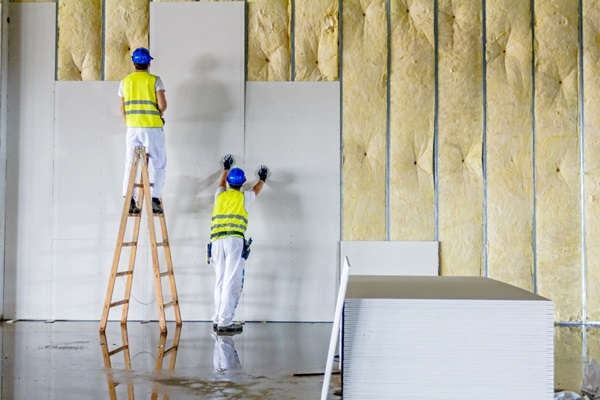Reliable Drywall Repair Techniques to Restore Your Wall surfaces
Reliable Drywall Repair Techniques to Restore Your Wall surfaces
Blog Article
Drywall Installation Facilitated: Tips for Perfect Results
Drywall installment is commonly regarded as a complicated job, yet with the best method and knowledge, it can become a manageable undertaking. Choosing quality products and preparing the installment area are important initial steps that establish the foundation for success. Furthermore, understanding methods for cutting, hanging, and completing drywall can dramatically influence the result. As we discover these vital tips, you might find that also the smallest modifications in your strategy can lead to remarkably improved outcomes, leaving you to think about just how these methods can change your next task.
Choosing the Right Materials
Selecting the proper products for drywall installation is vital to achieving a resilient and visually pleasing finish. drywall fort worth. The primary component, drywall sheets, normally come in various thicknesses, with 1/2-inch sheets being basic for indoor wall surfaces. For locations calling for additional moisture resistance, such as shower rooms or kitchen areas, take into consideration using eco-friendly board or concrete board, which are specifically made to withstand humidity

In addition, picking the appropriate bolts-- either nails or screws-- is necessary for protecting the drywall to the framing. Drywall screws are generally favored for their holding power and decreased danger of popping. Consider the finishing touches such as guide and paint, which not just enhance the look however also shield the drywall from dampness and wear.
Preparing the Setup Area
Before beginning the drywall installment process, it is necessary to prepare the installation location thoroughly. A clean work space reduces the threat of damages to existing things and allows for effective activity during setup.
Following, examine the wall surfaces and ceiling for any flaws, such as splits, openings, or mold. Address these problems beforehand; spot any kind of damages and enable adequate time for fixings to dry. Furthermore, ensure that electrical outlets, switches, and pipes are properly positioned and represented, as this will affect drywall placement.
Consider the ecological conditions. A steady temperature and humidity level are important for optimal adhesion and performance of the drywall products. Utilize a dehumidifier or heater to produce appropriate conditions. if necessary.
Cutting and Hanging Drywall
The trick to effective drywall installment lies in the precise cutting and dangling of the panels. Utilize a straight edge and an energy knife to rack up the drywall along your dimensions, then snap it along the racked up line for a clean break.

Constantly function from the top down and left to right, making certain that you preserve a staggered pattern to enhance security. Effectively hanging the drywall establishes the structure for a smooth finish, inevitably causing premium results in your drywall job.
Insulation and Mudding Strategies
While proper cutting and dangling of drywall sets the stage, the next critical action entails grasping taping and mudding methods to make sure a seamless finish. Taping is essential for enhancing joints and protecting against cracks; it entails embedding tape into the used joint compound (mud) Begin with a quality fiberglass or paper tape, using the tape over the joint and pressing it into the damp mud using a taping blade, ensuring no air bubbles remain.
When the tape remains in place, apply a thin layer of joint substance over the tape, feathering the edges to create a smooth shift to the drywall surface. Permit this layer to dry totally before sanding it lightly to get rid of flaws. Repeat this procedure, applying additional coats of mud as needed-- normally a couple of layers-- while slowly widening the application area with each layer to accomplish a smooth look.
After the final layer dries, sand the surface area with a fine-grit sandpaper up until smooth. drywall contractor. Keep in mind to use a mask during sanding to stay clear of inhaling dirt fragments. Understanding these taping and mudding strategies is important for attaining a professional-quality finish in your drywall installation
Completing Touches for Perfection
Achieving a flawless drywall installment exceeds taping and mudding; it culminates in the ending up touches that raise the general look. These final actions are crucial in making certain a professional-grade finish that enhances the looks of your space.
Begin by fining sand the dried joint substance to create a you can find out more smooth surface. drywall repair. After sanding, clean down the walls with a wet towel to remove any type of dirt bits, guaranteeing a tidy surface area for painting.
Next, apply a primer especially designed for drywall. This step is essential, as it assists secure the joint compound and provides an uniform base for the overcoat. As soon as the guide dries, examine for any type of flaws, and retouch as required.
Final Thought
In conclusion, successful drywall setup rests on the cautious selection of materials, thorough prep work of the installment area, and exact execution of reducing and hanging techniques. Mastery of taping and mudding processes is necessary for accomplishing a smooth coating. Furthermore, interest to finishing touches, consisting of priming and touch-ups, guarantees a professional-grade outcome. By adhering to these guidelines, the top quality of basics handiwork can from this source be substantially boosted, contributing to the total aesthetic and performance of the area.
Drywall installation is frequently regarded as a challenging task, yet with the right approach and understanding, it can end up being a convenient endeavor.Choosing the ideal materials for drywall installation is crucial to accomplishing a sturdy and cosmetically pleasing finish.Before starting the drywall setup procedure, it is crucial to prepare the installment location extensively. Understanding these taping and mudding methods is critical for achieving a professional-quality coating in your drywall installation.
In final thought, successful drywall installment pivots on the cautious option of materials, complete preparation of the installment location, and precise implementation of reducing and hanging strategies.
Report this page